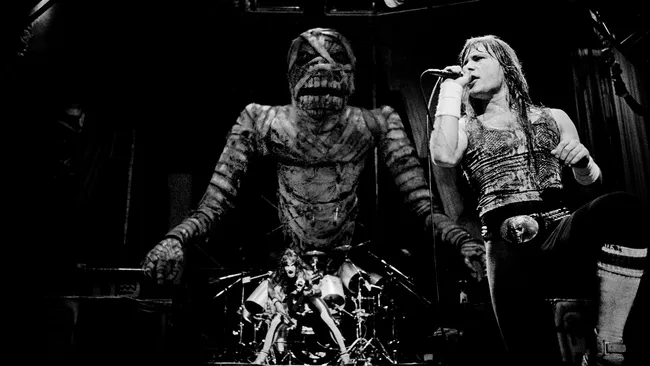

At the heart of it all stood the album Powerslave, a roaring, Egyptian-themed masterpiece that demanded an equally monumental live spectacle. And Iron Maiden, never a band to do things halfway, delivered.
The Birth Of A Monster
The Powerslave album had catapulted Maiden into the stratosphere. Featuring classics like “Aces High,” “2 Minutes to Midnight,” and the 13 minute epic “Rime of the Ancient Mariner,” it captured the band at their creative peak. To match that intensity onstage, they unveiled a jaw-dropping set design, an Egyptian temple complete with towering statues of their skeletal mascot, Eddie, who appeared as both a sarcophagus and a colossal mummy towering over the stage.
“It was ridiculous in the best possible way,” Bruce Dickinson later laughed. “Every night we’d walk out there surrounded by pyramids and hieroglyphs, with Eddie bursting out like some undead pharaoh. It was like Spinal Tap meets The Mummy, but louder.”
Crazed Fans, Chaos And Blood
The World Slavery Tour wasn’t just about spectacle, it was about survival. The band faced an almost nonstop schedule: months on the road with barely any breaks. The toll was physical, emotional, and, at times, bloody.
In one infamous incident, Dickinson accidentally split his forehead open mid-performance. Instead of calling it a night, he carried on, and that’s when the madness reached new heights.
“I split my forehead open,” Dickinson recalled. “Our tour manager looked at me and said, ‘Can you squeeze it and make it bleed some more? It looks great on the telly.’ So I did! The crowd went wild. That’s the kind of lunacy we were living in.”
Fans across the world mirrored that energy, from South American stadiums packed with 100,000 screaming die-hards to Eastern Bloc countries where heavy metal was still viewed as rebellion. In Poland and Hungary, the band played to audiences so frenzied that security forces had to intervene to stop fans from storming the stage.
The Cost Of Greatness
But behind the spectacle was growing exhaustion. The World Slavery Tour pushed Iron Maiden to their limits. The sheer scale of the production, hundreds of tons of gear, two Boeing 747s’ worth of cargo, and crews working around the clock, became a logistical nightmare.
By the time the band wrapped up in July 1985, after 331 days on the road, they were utterly spent. “We were completely burned out,” bassist Steve Harris admitted. “We’d achieved something unbelievable, but we were wrecked, physically and mentally.”
The exhaustion led to a lengthy break, the longest of Maiden’s career at the time, before regrouping to record Somewhere in Time in 1986. But that break was well-earned. They had not only survived the most grueling tour of their lives but had also redefined what a heavy metal show could be.
Legacy Of The Pharaohs
The World Slavery Tour remains legendary not just for its scale but for what it represented: a band at the peak of its powers, unafraid to dream big and bleed for their art, literally.
The tour was immortalized in the 1985 concert film Live After Death, recorded over four nights in Long Beach, California. To this day, it’s hailed as one of the greatest live recordings in rock history, capturing Iron Maiden in full flight, sweat, blood, and pyrotechnics included.
For Bruce Dickinson, the memories of that time are equal parts pride and disbelief. “We were young, invincible, and completely insane,” he said years later. “We didn’t know how to stop, and maybe that’s why the tour became what it did. We gave everything, every night, and somehow lived to tell the tale.”
Nearly forty years on, the World Slavery Tour stands as a monument to Iron Maiden’s fearlessness, a metal odyssey of mummies, mayhem, and pure rock ’n’ roll madness.
As Dickinson once put it:
“You can’t fake that kind of passion. You just have to live it, scars and all.”
Leave a Reply